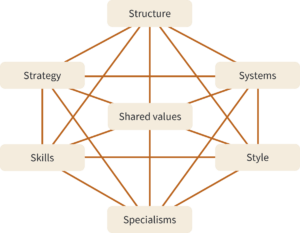Designers continually develop knowledge with customers, commissioners, users, fellow designers, partners, and other stakeholders. They acquire, create, and share knowledge of different sorts. This post explains which sorts of knowledge a team needs to accomplish design work.

Sorts of knowledge
A team’s organization rests on the following sorts of knowledge and their interrelationships.
- Strategy: the plan to accomplish design goals.
- Structure: the way of organizing design work.
- Systems: processes and procedures of design.
- Style: the way designing is approached.
- Specialisms: fields of specialization of designers.
- Skills: talents and abilities of designers.
- Shared values: accepted values, norms, and standards for designing.

These seven sorts almost entirely correspond with the seven internal factors in the McKinsey 7S Model. Other points of departure are conceivable, but the McKinsey 7S Model applies well in practice. Furthermore, many managers know this model. For a brief introduction to this model, see, for instance, Strategic Management Insight or Investopedia.
In practice, the two sorts Systems and Style can be hard or unnecessary to distinguish. For instance, a design team may define style as the processes and procedures the team members are used to follow. In such cases, you may conveniently combine the two sorts into one sort, System.
Framework for design knowledge
The seven sorts of knowledge and their interrelationships form a framework that can be used to:
- Analyze a design activity.
- Grow knowledge that is of interest to design work.
- Make design knowledge part of a team’s DNA.
